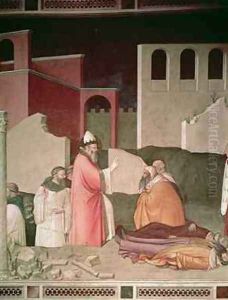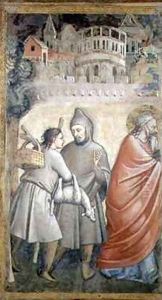Maso di Banco Giottino Paintings
Maso di Banco, sometimes referred to as Giottino, was an Italian painter of the early Renaissance period, active mainly in his hometown of Florence. His nickname 'Giottino' means 'little Giotto,' which indicates the influence of the great Florentine master Giotto di Bondone on his work. However, the moniker does not imply a familial relationship, and Maso di Banco's style, while clearly derived from the teachings of Giotto, also demonstrates his own artistic innovations and individuality.
Maso di Banco’s most significant contribution to the art world is his development of spatial representation in frescoes. His works are known for their architectural settings and use of perspective, which enhanced the three-dimensionality of the figures and the overall realism of the scenes. Notable works include the series of frescoes in the Bardi di Vernio Chapel in the Basilica of Santa Croce in Florence. These frescoes depict scenes from the life of St. Sylvester, including a celebrated representation of the 'Miracle of the Dragon,' which showcases his skills in creating a compelling narrative through detailed expressions and gestures.
Despite his clear talent and innovation, little is known about Maso di Banco’s life, and few works can be definitively attributed to him. Records of his life are scarce, and his career seems to have been somewhat overshadowed by the towering legacy of Giotto and the later generations of Renaissance artists who followed. Nevertheless, Maso di Banco is regarded as a critical figure in the transition from the medieval to the Renaissance style in Italian painting, bridging the gap between the Byzantine iconography and the naturalistic approach that came to define the Renaissance. His death is estimated to have occurred around 1350, but like much of his life, specific details are not well-documented.

